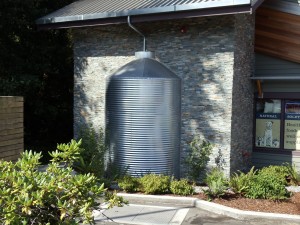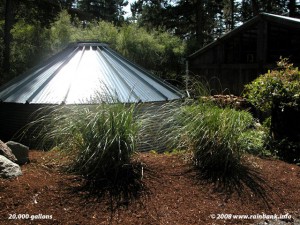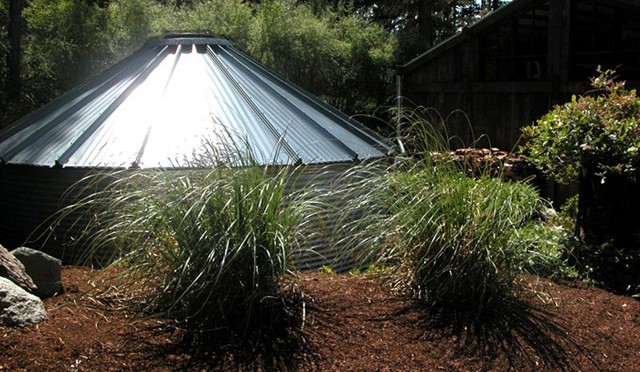This is Part 5 in the series “How to Build a Rainwater Collection System”. Click to see parts one, two, three and four.
 Steel water storage tanks for rainwater collection are generally bolted together grain silos adapted for this use. Made of galvanized corrugated steel panels, wall panels average 17 – 20 gauge with the galvanized roof panels being high rib or flat seam with a center hatch at the top and an access hatch near the bottom of the roof. A felt pre-liner is used between the steel and the main liner to protect it from abrasion. Liners are usually polyethylene and NSF approved when used for potable application or PVC, which is generally used for non-potable. However, PVC can be used for potable, as long as it is NSF approved. RainBank recommends polyethylene for this application.
Steel water storage tanks for rainwater collection are generally bolted together grain silos adapted for this use. Made of galvanized corrugated steel panels, wall panels average 17 – 20 gauge with the galvanized roof panels being high rib or flat seam with a center hatch at the top and an access hatch near the bottom of the roof. A felt pre-liner is used between the steel and the main liner to protect it from abrasion. Liners are usually polyethylene and NSF approved when used for potable application or PVC, which is generally used for non-potable. However, PVC can be used for potable, as long as it is NSF approved. RainBank recommends polyethylene for this application.
Steel tanks need to be built on a engineered cement slab with hold-down anchor brackets designed for the seismic zone where the tank will be placed. Plumbing for overflow, suction, discharge and any cross over lines used in multiple tank applications can either be PVC flanges, polyethylene or PVC boots if coming up through the cement slab. If penetrating through the side of the wall panels, PVC flanges will need to be used.
 Steel water storage tanks offer durability and protection of the liner from UV rays, plus offers an industrial or rural architectural look. Many commercial applications use this type of storage for both of these reasons. Overflow lines can be installed on the outside of the tank, but it is recommended that any pressurized lines be underground and frost protected in our Washington climate.
Steel water storage tanks offer durability and protection of the liner from UV rays, plus offers an industrial or rural architectural look. Many commercial applications use this type of storage for both of these reasons. Overflow lines can be installed on the outside of the tank, but it is recommended that any pressurized lines be underground and frost protected in our Washington climate.
Accessories include exterior ladders, platforms, and level gauges. The galvanizing does not need painting although if properly prepped, tanks can be painted to suit.
Assembly can be difficult for the homeowner or contractor, so it is recommended that a trained installer with the proper tools and knowledge be used.
Are you interested in building your own water harvesting system? Leave a comment below.

